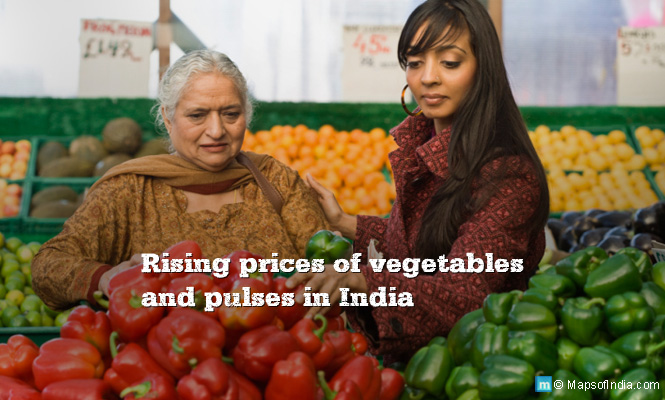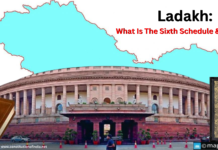The rising prices of vegetables and pulses have been a serious concern in Indian homes in recent years. If you think that it is only onions whose price is increasing, you are highly mistaken. The price of pulses like Arhar Dal has reached a maximum of Rs. 120 per Kg just recently. The sky-rocketing prices of vegetables and pulses have made an average middle class family think twice before buying or consuming them. Prices of these staples are soaring all across the nation. The big question is why is there constant food inflation?
Why the prices of pulses and vegetables are increasing at a continuous pace in India? It is not due to a poor harvest or a bad monsoon. Plus the country’s backbone is agriculture. There are various factors involved in the rising prices of these products:
1. Increase in the demand for protein-enriched food and green vegetables: The lesser-known Bennet’s law gives an important explanation for rising food prices. According to this law, when income rises or people become wealthier, they change their dietary habits, shifting their tastes from simple starchy plant-dominated diets to variety of food items, including a range of vegetables, fruit, protein rich food and dairy products. However, the supply of these vegetables and pulses is not adequate in comparison to their demand. Hence, the price rises.
2. Global inflation: Experts say that rise in essential food items in India is primarily because of the increasing commodity prices abroad, increase in fuel prices and fertilizers, which in turn affect the local produce by increasing input costs.
3. Less space for cultivation: With an increase in population, there is also an increase in the demand for vegetables and pulses. Increase in population has also led to increased urbanisation. Manufacturing, energy and service industries are all competing for land, water and human resources. With less availability of land, the prices for agricultural land are rising, leading to increased costs of agriculture produce.
4. Less production of pulses: Despite high wholesale pulse prices in recent years, farmers of India are not very keen on taking up cultivation of pulses due to high fluctuations in production and prices. There is no effective government price support mechanism. Farmers are keen on cash crops cultivation like cotton and maize because of better returns and lower risk. This was published in a research study by the National Council of Applied Economic Research. In the same study, it was also mentioned that production of pulses has recorded less than 1% yearly growth during the last 40 years, which is less than half of the growth rate in Indian population. As a result, per capita production and availability of pulses has witnessed sharp decline in India. This invariably leads to a rise in the price of pulses.
5. Improper management and distribution: An important question that arises is whether the agricultural produce has been stored and distributed optimally or not? There is always a gap in the food sector regarding this. Whenever, a report on climate change is published or a prediction of a flood or drought, there are instances of occurrence of supply shocks. Because of the short sightedness, the prices go up significantly. Deliberate spoilage of food due to inadequate storage and distribution reduces supply, thereby increasing the price.
6. Hoarding: The concept of keeping stock of food products like onions, potatoes, rice, pulses etc. even when the season is over and reselling at higher prices when there is demand is known as hoarding. In India, hoarding of essential commodities is very common and goods are sold at double the prices for increased profits.
7. Increased cost of transportation: With increase in fuel prices, the transportation charges also increase, leading to a rise in prices of all commodities, and vegetables and pulses are no exception.
8. Increased cost of production: One major cause of increase in the prices of vegetables and pulses is the rise in the prices of the raw materials required in the production starting from seeds, to fertilisers, pesticides, and labour costs. As a result, the cost of the end product also increases.
9. Many mediators: In India’s trading community, the end product reaches the consumer after passing through various mediators or middlemen. Each mediator tries to get profits by increasing the original cost and the end price becomes very high than the actual price. So, it is very common in India that we, as consumers, pay a high price and at the same time the farmers do not get a deserving price for the same food product.
10. Supply chain mismanagement: There has been mismanagement in the supply chain of vegetables and pulses from the farmers to the consumers. According to reports, the difference in wholesale and retail prices is anywhere between 40% and 60% and this margin is more within cities where there are the wholesale markets. Some of the major issues related to supply chain mismanagement in India are lack of rural infrastructure, inadequate and ill-equipped mandis, lack of proper handling and no direct marketing by “farmers to consumers.”
Read More:
Is Most of India Vegetarian? – An Infographic
What Is The Government Doing To Curb The Rising Vegetable Prices?
Why Petrol Price is Rising in India?
Why LPG price rising in India?
Why is the gold price falling in India
Onion price rise in India– A critical issue




